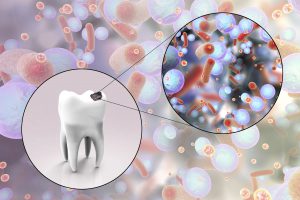
Dental caries is defined as the progressive destruction of a tooth and is considered a major health issue in both adolescents and adults, in which reportedly 90% of the population is affected(1). Cavities are formed when acid erodes the hard tissues of the teeth (enamel, dentin and cementum).
Acid is produced in the mouth when certain bacteria, such as Streptococcus mutans, ferment sugars into acid. For decades, S. mutans was believed to be the main bacteria involved in caries initiation and progression. This is no longer the case, as current research has demonstrated many bacteria are play a role in the initiation and progression of caries(2). Detecting S. mutans alone is no longer good enough. Any bacteria able to live in dental plaque, and ferment sugar into acid, could possibly cause cavities.
Aside from S. mutans, two of the most prevalent bacteria involved caries initiation and progression are Streptococcus sobrinus and Lactobacillus species(3-4). S. sobrinus is often found in individuals that lack S. mutans(5). Lactobacillus species are typically more acidogenic, or acid forming, than Streptococcus species and are often involved in the progression of a cavity.
If an individual presents with these bacteria in their plaque, and eats sugar, they are likely to eventually develop a cavity. Screening for the presence of these three bacteria, by utilizing simple salivary tests such as the new OraRisk® Caries, allows dental providers to determine which patients are likely to develop caries before signs of a cavity are even visible. The appropriate intervention and treatment can then be applied to those patients at risk.
References:
1. CDC National Center for Health Statistics: https://www.cdc.gov/nchs/data/databriefs/db197.htm
2. Marsh P, Head D, Devine D. J Oral Biosci. 2015; 57 (4): 185–191.
3. Bourgeois D, et al. PLoS ONE. 2017; 12(10): e0185804
4. Caufield P, et al. J Dental Res 2015; 94(9):110-118.
5. Okada M, Kawamura M, Oda Y, Yasuda R, Kojima T, Kurihara H. Int J Paediatr Dent 2012; 22: 3428.
For more information on how to become an OralDNA Provider – scan HERE: 
- OraRisk® Caries: Identifying Bacteria for Risk Assessment - December 28, 2018
- OraRisk® Caries: Identifying Bacteria for Risk Assessment - October 5, 2018
- Definitions By Matt: What is PCR? - November 10, 2017
